Friday, July 30, 2010
WHERE I WORK IN QUEENS
TRINKETS FROM A WORKSHOP - Images by Tiffany Clark
TIME COVER: CONTROVERSIAL AND TRUTH TELLING

Our cover image this week is powerful, shocking and disturbing. It is a portrait of Aisha, a shy 18-year-old Afghan woman who was sentenced by a Taliban commander to have her nose and ears cut off for fleeing her abusive in-laws. Aisha posed for the picture and says she wants the world to see the effect a Taliban resurgence would have on the women of Afghanistan, many of whom have flourished in the past few years. Her picture is accompanied by a powerful story by our own Aryn Baker on how Afghan women have embraced the freedoms that have come from the defeat of the Taliban — and how they fear a Taliban revival.(See pictures of Afghan women and the return of the Taliban.)
I thought long and hard about whether to put this image on the cover of TIME. First, I wanted to make sure of Aisha's safety and that she understood what it would mean to be on the cover. She knows that she will become a symbol of the price Afghan women have had to pay for the repressive ideology of the Taliban. We also confirmed that she is in a secret location protected by armed guards and sponsored by the NGO Women for Afghan Women. Aisha will head to the U.S. for reconstructive surgery sponsored by the Grossman Burn Foundation, a humanitarian organization in California. We are supporting that effort.(Watch TIME's video on photographing Aisha for the cover.)
I'm acutely aware that this image will be seen by children, who will undoubtedly find it distressing. We have consulted with a number of child psychologists about its potential impact. Some think children are so used to seeing violence in the media that the image will have little effect, but others believe that children will find it very scary and distressing — that they will see it, as Dr. Michael Rich, director of the Center on Media and Child Health at Children's Hospital Boston, said, as "a symbol of bad things that can happen to people." I showed it to my two young sons, 9 and 12, who both immediately felt sorry for Aisha and asked why anyone would have done such harm to her. I apologize to readers who find the image too strong, and I invite you to comment on the image's impact.(Comment on this cover.)
But bad things do happen to people, and it is part of our job to confront and explain them. In the end, I felt that the image is a window into the reality of what is happening — and what can happen — in a war that affects and involves all of us. I would rather confront readers with the Taliban's treatment of women than ignore it. I would rather people know that reality as they make up their minds about what the U.S. and its allies should do in Afghanistan.(See the cover story "Afghan Women and the Return of the Taliban.")
The much publicized release of classified documents by WikiLeaks has already ratcheted up the debate about the war. Our story and the haunting cover image by the distinguished South African photographer Jodi Bieber are meant to contribute to that debate. We do not run this story or show this image either in support of the U.S. war effort or in opposition to it. We do it to illuminate what is actually happening on the ground. As lawmakers and citizens begin to sort through the information about the war and make up their minds, our job is to provide context and perspective on one of the most difficult foreign policy issues of our time. What you see in these pictures and our story is something that you cannot find in those 91,000 documents: a combination of emotional truth and insight into the way life is lived in that difficult land and the consequences of the important decisions that lie ahead.
To learn more about Aisha and her reconstructive surgery in the U.S., visit www.GrossmanBurnFoundation.org.
Read more: http://www.time.com/time/world/article/0,8599,2007269,00.html#ixzz0vB4upiDn
TO VIEW MORE ABOUT THE STORY, SEE VIDEO AND COMMENTS FOLLOW THIS LINK: http://bit.ly/9uzzea
Thursday, July 29, 2010
Monday, July 26, 2010
Sunday, July 18, 2010
Sunday, July 11, 2010
Friday, July 9, 2010
"LILIANA: A CHILD MOTHER"
Liliana Servin, from Mexico City, is a 16 year old mother of two who, up until 2 weeks ago, has been living on the streets of Mexico City since she was 7 years old. The Daya Shelter located in Cuajimalpa, a small town on the outskirts of Mexico City, has taken Liliana and many other girls in the same situation in to help the girls learn how to take care of their babies and children while also learning "normal" everyday tasks like cooking, laundry, cleaning, going to school, and working to prepare these young mothers how to get back into society. Liliana was admitted to Daya on June 6th, a little over a week after she gave birth to Reyna Yolanda on May 27th, 2008. Liliana, whose mother died at age 6, moved to the streets after being sexually abused multiple times by her uncle. The father of Reyna, who Liliana refers to as her husband, is working hard on making enough money to be able to get a nice place for all of them to live. Even though Liliana is happy to not be living on the streets right now, she does not want her stay at the shelter to be long so she can get back to her "husband" and also to be able to see her 3 year old son who lives with her aunt.
Photos by Tiffany L. Clark
© A Child Mother - Images by Tiffany Clark
A RELEASE: A STORY ON SELF- INJURY
© Release: A Story of Self-Injury - Images by Tiffany Clark













